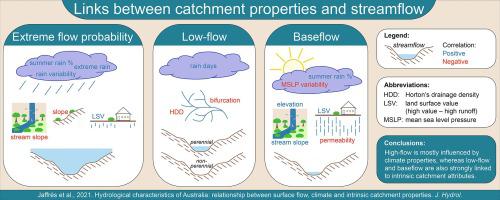Journal of Hydrology ( IF 6.4 ) Pub Date : 2021-09-08 , DOI: 10.1016/j.jhydrol.2021.126911 Jasmine B.D. Jaffrés 1 , Ben Cuff 1 , Chris Cuff 1 , Iain Faichney 1 , Matthew Knott 1 , Cecily Rasmussen 1

|
Streamflow and baseflow dynamics are driven by complex, interconnected catchment properties. A national study was conducted to assess the relationship between surface flow, climate and intrinsic catchment attributes in Australia. Subcatchments were delineated based on Horton's 5th stream order and were characterised by identifying parameters that influence streamflow and flood behaviour. Because observational datasets like rainfall and streamflow commonly have a non-normal distribution, the method of L-moments was applied to several time series. Surface hydrology and baseflow patterns were represented by twenty indices, which were statistically summarised via principal component (PC) analysis, yielding six PCs. Forty catchment descriptors from the themes of climate, topography, surface condition and hydrogeology were used to investigate their link with runoff patterns. Among these is the land surface value, a newly defined index incorporating soil properties and land use to estimate the capacity for water infiltration. All metrics were explored via correlation and regression analysis against the surface hydrology PCs and their influence on runoff discussed. The predictive skill of the regression models is improved when non-perennial waterways are excluded. Although rainfall characteristics dominate streamflow behaviour, topographical and surface conditions also greatly impact on runoff, especially during low-flow periods.
中文翻译:

澳大利亚的水文特征:地表流量、气候和内在流域特性之间的关系
溪流和基流动力学由复杂的、相互关联的流域特性驱动。进行了一项全国性研究,以评估澳大利亚地表流量、气候和内在流域属性之间的关系。子汇水面积是根据 Horton 的第 5 条河流顺序划定的,并通过识别影响河流流量和洪水行为的参数来表征。由于降雨和径流等观测数据集通常具有非正态分布,L的方法-moments 应用于几个时间序列。地表水文和基流模式由 20 个指标表示,通过主成分 (PC) 分析对这些指标进行统计总结,产生 6 个指标。使用来自气候、地形、地表条件和水文地质等主题的 40 个流域描述符来研究它们与径流模式的联系。其中包括土地表面值,这是一个新定义的指标,结合了土壤特性和土地利用,用于估计水渗透能力。所有指标都通过对地表水文 PC 及其对径流影响的相关性和回归分析进行了探讨。当排除非多年生水道时,回归模型的预测能力得到提高。尽管降雨特征主导着水流行为,


























 京公网安备 11010802027423号
京公网安备 11010802027423号